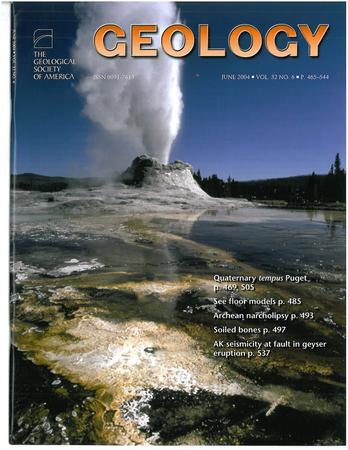Long-term evolution, stability, and thickness of cratonic lithosphere
IF 4.6
1区 地球科学
Q1 GEOLOGY
引用次数: 0
Abstract
The thickness of the cratonic lithospheric mantle (CLM) influences the composition of primary mantle melts, the formation and distribution of ore deposits, and the stability of continents. However, it remains debated whether the thickness of the CLM has changed through time. Some studies suggest progressive thinning due to extension, convective removal, mantle plumes, or subduction-driven erosion, while others propose long-term stability due to the intrinsic buoyancy or strength of the CLM. To address this question, we provide new constraints on the evolution of the CLM through time by comparing two recently developed datasets: (1) a global dataset of paleo−lithosphere-asthenosphere boundary (LAB) depth estimates (dating back to 2.1 Ga) produced by fitting geotherms to xenolith- and xenocryst-derived pressure and temperature estimates; and (2) the present-day LAB depth derived from seismic tomography combined with a scaling between wavespeed and temperature. Our results show that the thickness of the CLM beneath most cratons has changed by <50 km since the Paleoproterozoic, that there are no systematic secular trends in CLM thickness changes through time, and that there is no evidence for the previously proposed existence of substantially thicker (>300 km) CLM in the past. These findings suggest that in the majority of places, the cratonic lithosphere has remained largely unchanged for billions of years, reinforcing the idea that cratonic roots represent long-lived, stable features of Earth’s lithosphere. Exceptions are regions with long histories in a supra-subduction setting, followed by the application of extensional stresses (e.g., North China).克拉通岩石圈的长期演化、稳定性和厚度
克拉通岩石圈地幔的厚度影响着原生地幔熔体的组成、矿床的形成和分布以及大陆的稳定性。然而,CLM的厚度是否随着时间的推移而改变仍存在争议。一些研究认为,由于伸展、对流移除、地幔柱或俯冲驱动的侵蚀,CLM逐渐变薄,而另一些研究则认为CLM的内在浮力或强度导致了长期稳定。为了解决这一问题,我们通过比较最近开发的两个数据集,为CLM随时间的演化提供了新的约束条件:(1)一个全球古岩石圈-软流圈边界(LAB)深度估计数据(可追溯到2.1 Ga),该数据是通过将地热拟合到捕虏体和xenocrite衍生的压力和温度估计中得到的;(2)地震层析成像结合波速和温度之间的标度得到的现今LAB深度。我们的研究结果表明,大多数克拉通下面的CLM厚度发生了&;lt;自古元古代以来,CLM厚度随时间变化没有系统的长期趋势,并且没有证据表明先前提出的在过去存在明显更厚(>300 km)的CLM。这些发现表明,在大多数地方,克拉通岩石圈数十亿年来基本保持不变,这加强了克拉通根代表地球岩石圈长期稳定特征的观点。例外情况是,在超俯冲环境中具有长期历史的地区,其次是伸展应力的应用(例如华北)。
本文章由计算机程序翻译,如有差异,请以英文原文为准。
求助全文
约1分钟内获得全文
求助全文
来源期刊

Geology
地学-地质学
CiteScore
10.00
自引率
3.40%
发文量
228
审稿时长
6.2 months
期刊介绍:
Published since 1973, Geology features rapid publication of about 23 refereed short (four-page) papers each month. Articles cover all earth-science disciplines and include new investigations and provocative topics. Professional geologists and university-level students in the earth sciences use this widely read journal to keep up with scientific research trends. The online forum section facilitates author-reader dialog. Includes color and occasional large-format illustrations on oversized loose inserts.
 求助内容:
求助内容: 应助结果提醒方式:
应助结果提醒方式:


